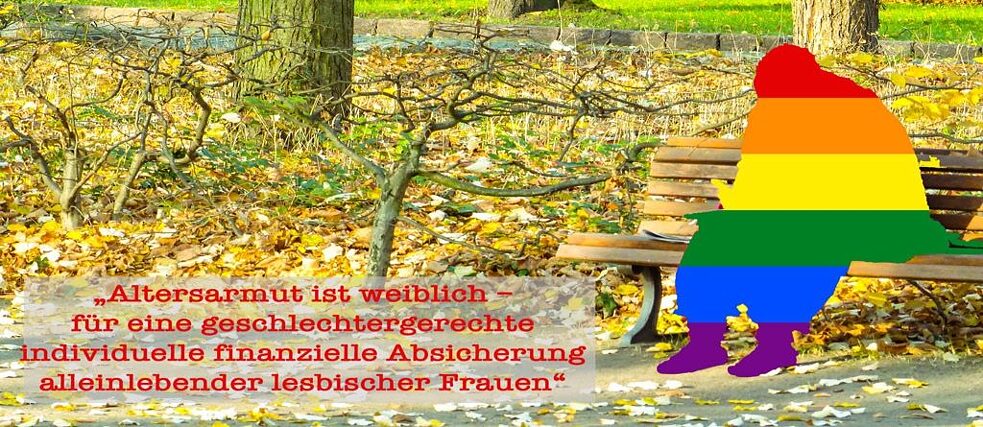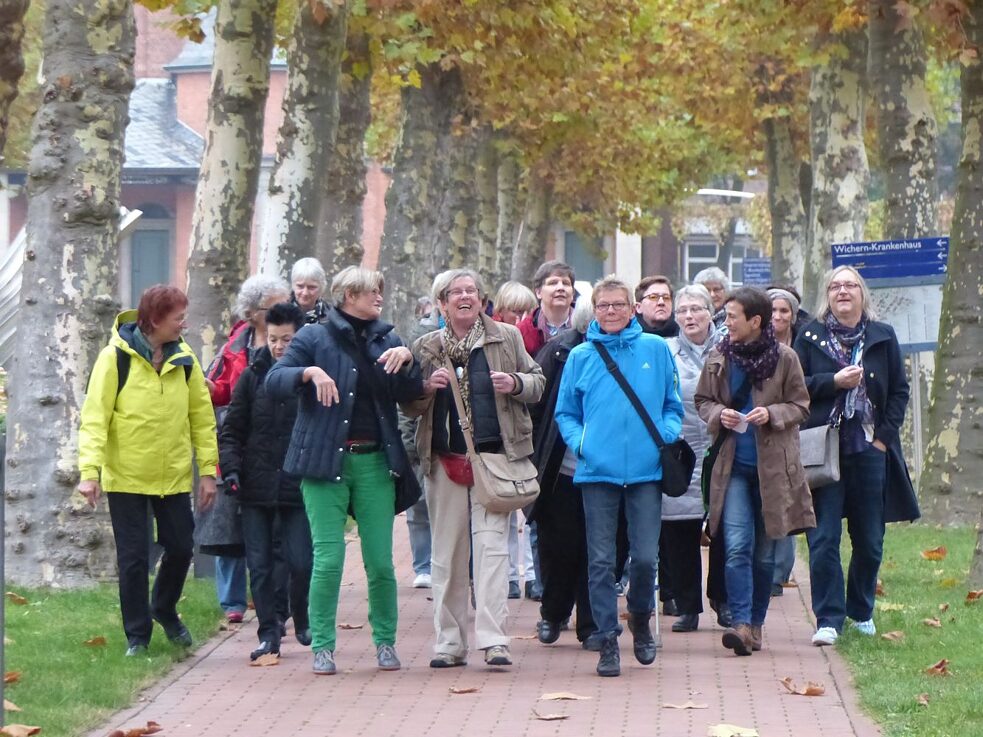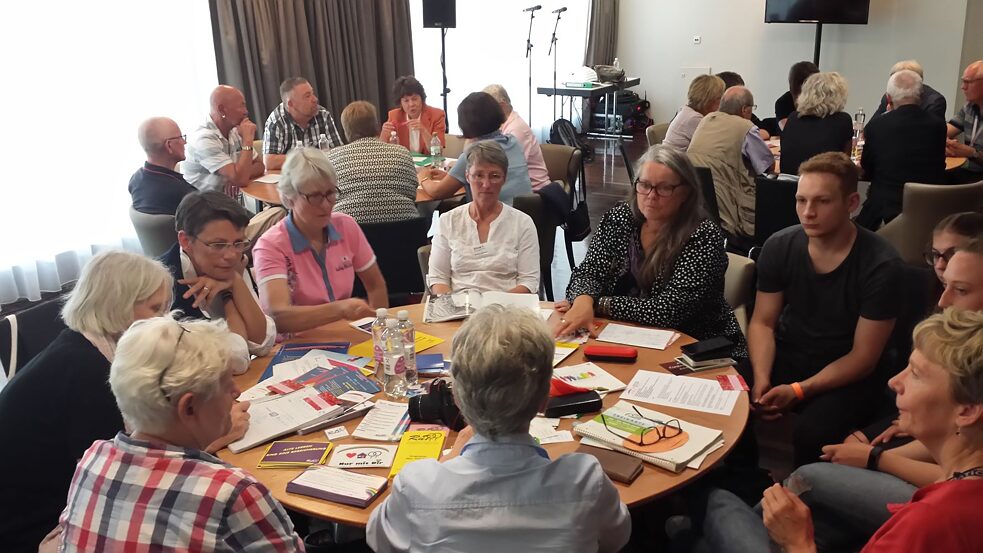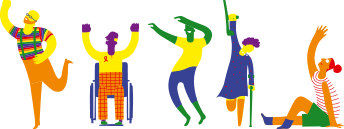Queer Aging
We only lower our heads to look at our beautiful shoes

How do queer people plan their old age? Sabine Arnolds of the umbrella organization Lesben und Alter explains why older queer people need to be part of Pride and how we can approach one another with respect.
By Sabine Arnolds
“Wrinkles are wrinkles. But all people want their personal lives to be perceived and respected in their old age and that’s exactly what we’re about, too,” says Reingard Wagner, board member of the Dachverband Lesben und Alter (Lesbians and Aging Umbrella Association) and member of the Advisory Board of the nationwide project Queer im Alter (Queer in Old Age) by the social association AWO (Arbeiterwohlfahrt). I get to know Reingard and her board co-members as confident, tough yet quiet but persistent in January 2019. Since the middle of February, I have been accompanying the association as a consultant and assisting the voluntary board members and affiliate organizations.
And the icing on the cake?
This is a dream job for me. It’s underpaid, like all jobs in the social sector. For that, I have a lot of leeway, can contribute ideas and help enforce the concerns of the association. According to recent estimates, there are about half a million lesbian women over the age of 65 in Germany and the numbers grow when we calculate the increasing age pyramid. We are struggling to make their needs audible and visible, arguing passionately with politicians, social organizations and in our own community, forming alliances and collaborating. Together with BISS, our gay counterpart organization, earlier this year we launched the campaign “CSD ist für Alte da” (CSD is here for elders). Because as they age, the generation that first took to the streets, out and proud, and fought for the rights of LGBTIQ* people is increasingly disappearing from pride demonstrations and festivities.“CSD is here for elders”
A similar campaign by the US NGO for queer older people SAGE served as the model for these suggestions to the pride parade organizers. Many of the suggestions can be implemented easily and quickly. Whether bicycle rickshaws for those who have trouble walking, or elder advisory panels who help with preparation – various pride parades are already committed to giving space and visibility to the original champions of our freedoms. The coalition of pride events CSD Deutschland supports “CSD ist für Alte da.”No publicity
The issue of visibility is a recurring story for lesbian women in particular. “The visibility of lesbians is a long-burning issue within the lesbian-feminist community,” says Carolina Brauckmann, also a board member of the umbrella organization (“Alt, sichtbar, autonom? Ein Generationenthema,” in: Lesben raus!: Für mehr lesbische Sichtbarkeit, edited by Stephanie Kuhnen, Querverlag 2017). Participants on the way to the 2015 conference “What Lesbian Women Dream of: Social provisions in old age”
| Photo: Doris Leymann © archives of the Dachverband Lesben und Alter
Older and single women are rarely seen in public or on television and – with the exception of the comedy and acting icon Maren Kroymann who just passed the age of 70 – lesbian older and single women aren’t seen at all. In heterosexual environments, some of them creep back into the closet, experiencing their coming-in, so to say. Whether senior facilities, nursing homes or nursing services: Tacitly, most of them today still assume that their clients are heterosexual.
Participants on the way to the 2015 conference “What Lesbian Women Dream of: Social provisions in old age”
| Photo: Doris Leymann © archives of the Dachverband Lesben und Alter
Older and single women are rarely seen in public or on television and – with the exception of the comedy and acting icon Maren Kroymann who just passed the age of 70 – lesbian older and single women aren’t seen at all. In heterosexual environments, some of them creep back into the closet, experiencing their coming-in, so to say. Whether senior facilities, nursing homes or nursing services: Tacitly, most of them today still assume that their clients are heterosexual.
The Stonewall generation is aging
The irony of it all is that lesbians were among the first queer activists of the Stonewall generation, the women’s and lesbians’ movement, who asked and sought to answer these questions: How do we want to live in old age? How, after the leaden era of the 1950s, do we retain our newly gained autonomy for as long as possible? As early as the 1980s, an organization was founded called SAFIA Lesben gestalten ihr Alter, which quickly led to the first residential project. The RuT initiative, a Berlin lesbian consulting center, was founded in 1989 by elder lesbians. From the start, they invited the older target group into their barrier-free rooms.How do we want to live in old age?
Since the turn of the millennium, the movement has gathered speed. Increasingly, groups, projects like visiting services, professional dialogs and, in 2004, a mailing list grew to become the first nationwide conference on lesbians and aging. Lectures and workshops covered almost every subject that is still the focus of work for queer elders: promotion of health, suitable recreational activities, nursing, alternative residential models. Carolina Brauckmann was as instrumental as Reingard Wagner, Jutta Brambach, Sabine Thomsen and Kirsten Plötz, who are currently the directors of the umbrella organization. Seminar participants discuss ways to introduce diversity to work with seniors
| Photo: Carolina Brauckmann © archives of the Dachverband Lesben und Alter
That same year, for the first time the Kuratorium Deutsche Altershilfe published a special magazine on homosexuality in old age with interviews and background reports. And a diploma thesis dealt with the life situations of elder lesbian women (Marion Worthmann: Aspekte der Lebenslage lesbischer Frauen im Alter, 2004).
Seminar participants discuss ways to introduce diversity to work with seniors
| Photo: Carolina Brauckmann © archives of the Dachverband Lesben und Alter
That same year, for the first time the Kuratorium Deutsche Altershilfe published a special magazine on homosexuality in old age with interviews and background reports. And a diploma thesis dealt with the life situations of elder lesbian women (Marion Worthmann: Aspekte der Lebenslage lesbischer Frauen im Alter, 2004).
It begins with the right wording
Fascinated, I trace depictions of how 15 years ago – as in the years before and again today – people wrestled with the word “lesbian.” Every single initiative reports of the difficulties of reaching those who don’t like to call themselves lesbians, even reject the word or circumvent any descriptive terms. The historian Kirsten Plötz asks who the word lesbian includes and excludes and whether one term that appeals to all is even possible.Listen sensitively to nuances
One story touches me so much that finding the right term seems irrelevant. Social worker Bea Trampenau tells the story of two elderly women who lived together in one room and pushed their beds together night after night to feel close to each other. “This went well until one night the beds slid apart and one of the women fell out.” (Lesben und Alter, documentation of the national conference in 2004, edited by Intervention e.V.) Who cares at this point how the two define(d) themselves? I admire their persistence. They take care of themselves. And I hope that the nursing home ensured that they would be able to pursue their desire for closeness with their partner/girlfriend/loved one in the future. It becomes clear that lesbians are committed to ensuring that caregivers deal sensitively with residents and clients, listen to nuances and, in case of doubt, know about community offers.Queerness in the nursing home
My parents-in-law have been living in a nursing home for some time. Whenever I visit them, I wonder if among the predominantly single women living there some may also be women loving. Are their needs met? On their first day there, my gentle little mother-in-law very doggedly insisted that the spouses’ beds be placed side by side and firmly anchored so that neither can fall between the beds. Would a lesbian or gay couple have done the same? If you know of an example, please let me know.The fruits of our work are now ripening
From the beginning, queer elder projects sought to collaborate with institutions of care and to influence care structures, sought contact with social associations and the housing industry. The fruits of our work are now ripening. The two lesbian and gay senior associations are members of the German National Association of Senior Citizens’ Organizations (BAGSO) and were represented at the German Senior Conference in 2018 with a joint stand and a workshop on elder lesbians and gays in senior citizen work. Our giveaways, small souvenir water bottles, were very popular. We are increasingly being invited to take part in working groups and appointed to advisory councils. The expertise of both associations is being heard and is in demand. We do a great job with weak structures and little money. This would hardly be possible without a lot of volunteer work by the respective board members.Old-age poverty is female
Getting a lot done with scarce resources – the generation of women’s movement lesbians is familiar with it. Without their energetic groundwork, there would have been no initiatives against violence against women, no women’s shelters or projects against sexual abuse like Wildwasser. Frequent work in underpaid (if at all) and all-too-often temporary jobs makes itself painfully noticeable elsewhere today. The pensions of lesbian women are often small. Pension and social policies, flawed for decades, have dire consequences for those who brought about equality policy and social change. Illustrated figures for the campaign “CSD ist für Alte da!” (CSD is here for elders)
| illustration: Kirsten Piepenbring
But they’re not putting their heads in the sand, but setting off once again both individually and structurally. “Old-age poverty is female – for gender-equitable individual financial security of lesbian women living alone in old age” was the title of an initiative in October 2019 in which participants sought improvements in the pension system that disadvantages women. It has been known for some time that the gender pay gap doubles to become a pension pay gap at retirement age.
Illustrated figures for the campaign “CSD ist für Alte da!” (CSD is here for elders)
| illustration: Kirsten Piepenbring
But they’re not putting their heads in the sand, but setting off once again both individually and structurally. “Old-age poverty is female – for gender-equitable individual financial security of lesbian women living alone in old age” was the title of an initiative in October 2019 in which participants sought improvements in the pension system that disadvantages women. It has been known for some time that the gender pay gap doubles to become a pension pay gap at retirement age.Almost all of the older lesbian women I’ve met so far continue to work after retirement age – to augment their small pension income, but also to continue doing something meaningful. The memoirs of Lotti Huber, a queer icon of the early 1990s, were called Diese Zitrone hat noch viel Saft: This Lemon Still has Plenty of Juice. It’s a phrase that has been going through my head a lot over the past few months, full of admiration for that generation.
Rewriting the role of the old woman
The legal scholar and feminist Marie Sichtermann wrote in an essay a few years ago, “I’m almost 60 years old and I know that my generation has to rewrite and orchestrate the role of the old woman. It can’t be about us being fit, elegant, athletic and witty, taking our sheep to an island in the Mediterranean, smoking our little pipe and always looking ten years younger. How, who and what do we want to be when we’re 75?” (see “Frauen, Macht und Politik,” also in Carolina Brauckmann, Alt, sichtbar, autonom?).Today, Marie Sichtermann has reached that age, continues to hold lectures, speak at events and co-organize conferences. Like anyone, she wants to share memories as she ages, she said in 2014 in the video lesbisch.schwul.älter. This includes not having to explain abbreviations like LFT or CSD (for those who don’t share this experience, LFT stands for Lesbenfrühlingstreffen, an annual spring meeting for lesbian women for over 40 years, CSD stands for Christopher Street Day).
Culturally sensitive nursing – even if it hadn’t been given the name yet – and curricula for nursing schools already played a role in 2004. But the first textbook about it won’t be published until 2020: LSBTIQ* und Alter(n) – Ein Lehrbuch für Pflege und Soziale Arbeit. It’s been a long pathway and we haven’t reached the end of it yet.